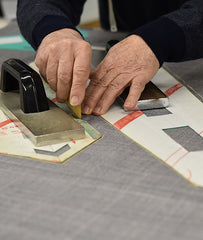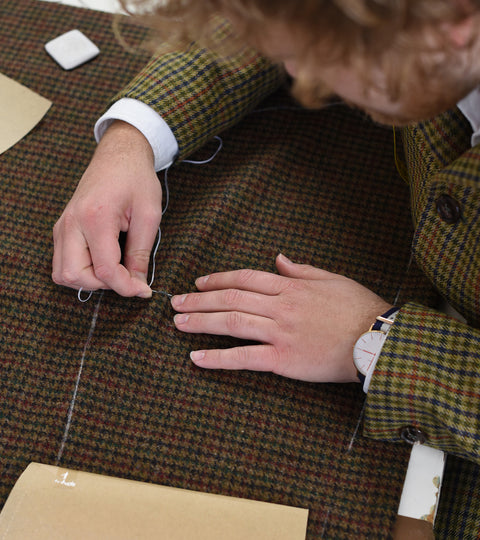The Lure of Hand Work
In an age of mass production, handwork is a paradox. On the one hand, it’s a throwback to pre-industrial production, a remnant, a holdover. On the other hand, it’s valorised all the more because it’s now a rarity. The machines have taken over daily life to such an extent that devices of unimaginable complexity are routine companions. Manual skill, by comparison, has become a kind of magic.
What separates a painting from its numerous prints?

Among the fields of human industry, food and clothing stand out as those yet to be comprehensively automated.

There are good reasons to care about how things are made, and how the makers are treated. But there’s also the lure of the craft itself. Humans can make a fetish of anything. Observe Tom Wolfe describing “the secret vice,” working buttonholes:

But the machines came for those too. Now any mass manufactured suit can boast working buttonholes that are no more the sign of artisanal labour than contrast stitching.

Now it’s the handmade buttonhole: the silk thread, the individual knots, the hours of time that it takes to make a good set. Best of all is the Milanese style lapel buttonhole (confusingly now associated with French tailors), made even sleeker and more challenging by putting all the knots on the underside of the cloth. If someone eventually invents a machine to make a perfect Milanese, no doubt some other evidence of genuine handwork will be uncovered to make up the difference. Mass produced luxury is no longer luxury, after all.
The History
How did we get here? In the beginning, all work was handwork because there were no machines and no factories. The pre-industrial European garment industry was a hugely complex network of small producers, makers, merchants, wholesalers, and vendors. A Shetland farmer might sell wool to a spinner, who would wash and spin it into thread, and sell it to a weaver who would make it into a cloth, before selling it to a tailor to cut and sew. In practice, that chain of buyers and sellers would be impossible to organise without a network of middlemen, and larger merchants could outsource specialist tasks to spinners or weavers without losing ownership of the product.

But not everything disappeared. Artisans became seasonal workers, crafts morphed from professions into hobbies, and the very best continued to offer a handmade product because they knew no machine could match their talents. In areas where tradition and artistry were most important (luxury tailoring, couture fashion, military uniforms) hand tailoring persisted. In places where artisanal textiles were celebrated as cultural history (from hand-loomed Scottish tweeds to Indian khadi and Japanese kasuri), they persisted.
What is best? There’s room for debate. To give the modernists their due, machine made cloths are smoother and finer, machine stitching is straighter and stronger,

Modern garments are without a doubt more comfortable and higher performance on average than pre-industrial garments. They are also plentiful in ways that would have seemed impossible a century or two ago. But to the traditionalist’s credit, more is not always better, and we are well past the point of having enough production. Handwork isn’t everything, but there are places where it makes a functional difference, above and beyond the preservation of craft for its own sake.
The Details
So what should you look for in a garment that combines the best of modern manufacturing and artisanal skill? How do you avoid the cynical imitation of craft, like the machine-made functional cuff buttons on a jacket, that add no charm and actually make the garment worse by making alterations needlessly expensive?

In shirts, look for hand-attached sleeves and collars. A hand-attached sleeve can be fed into the armhole more neatly, and adjusted throughout the process, and a larger sleeve can be fitted into a tighter armhole, making for a cleaner finish. Beyond that, some details are nice to have, such as hand-attached buttons (with their tell-tale ‘crow’s foot’ stitch) and handmade gussets, but these are only aesthetic.
In tailoring, the same logic applies, with the addition of the padding and canvassing that runs through the collar and chest of a tailored jacket. Here too, hand-padding allows for a genuinely three dimensional shape to be produced, helping to explain why bespoke garments sometimes look more sculpted than their industrial cousins.

Inside the jacket, hand-sewn seams using a slip stitch are said to increase elasticity and comfort, though some consider machine-sewn long seams preferable for strength. In both trousers and jackets, details such as handmade buttonholes and bar-tacks are nice to have but strictly aesthetic.
A quality tie is distinguished by a single hand-sewn slip stitch running from blade to tail. This stitch adds extra give into the silk, removes strain, and allows the tie to spring back into shape when untied.
Bespokes shoes are a big topic for another time. For now I’ll just mention that hand-welting (stitching) allows the maker to work much closer to the upper of the shoe, making for a sleeker silhouette and a finer finish than the machine-made equivalent.
Alex Freeling is a freelance writer and self-proclaimed bar tack aficionado. Alex mainly writes on craft & luxury menswear, as well as fragrance and lifestyle. He has been a contributor to publications like GQ, Robb Report, and The Rake.
Follow Alex Freeling on Instagram @afreeling
* Most pictures taken at our tie maker in Italy, and Dutch bespoke tailor ANTON-Kleermaker

